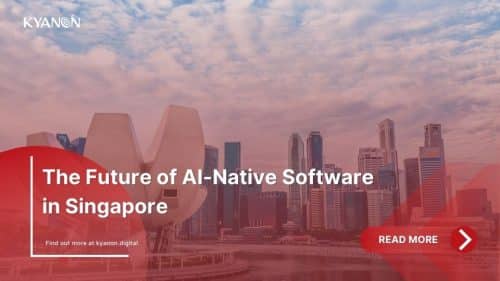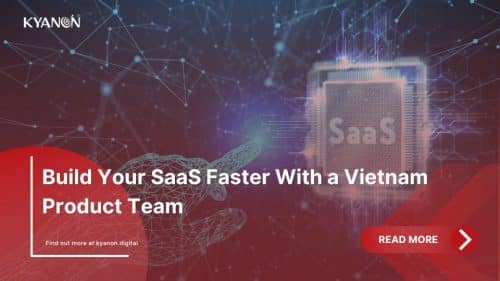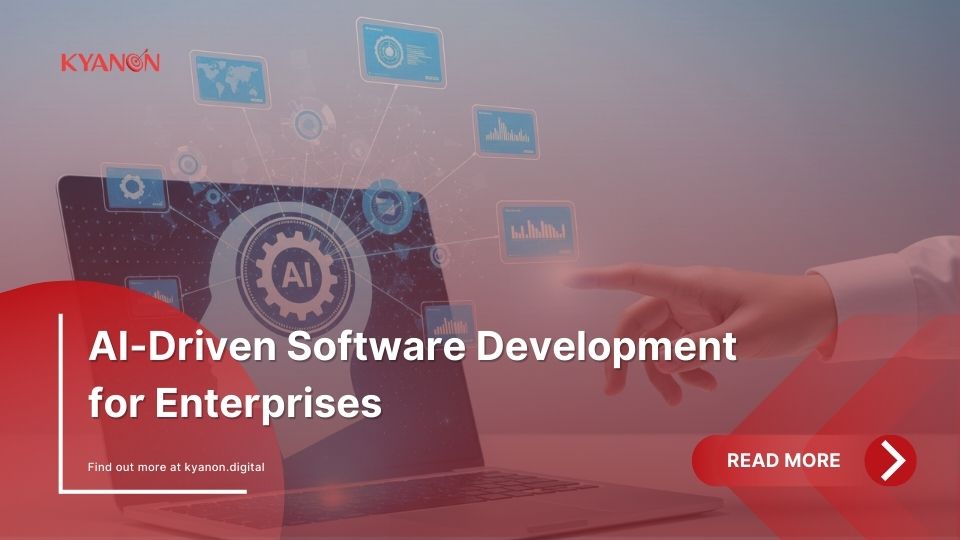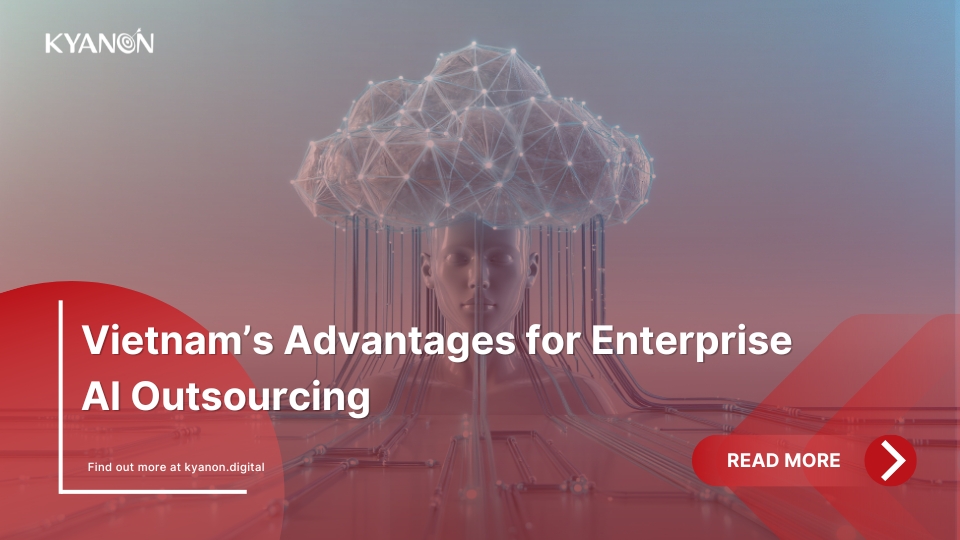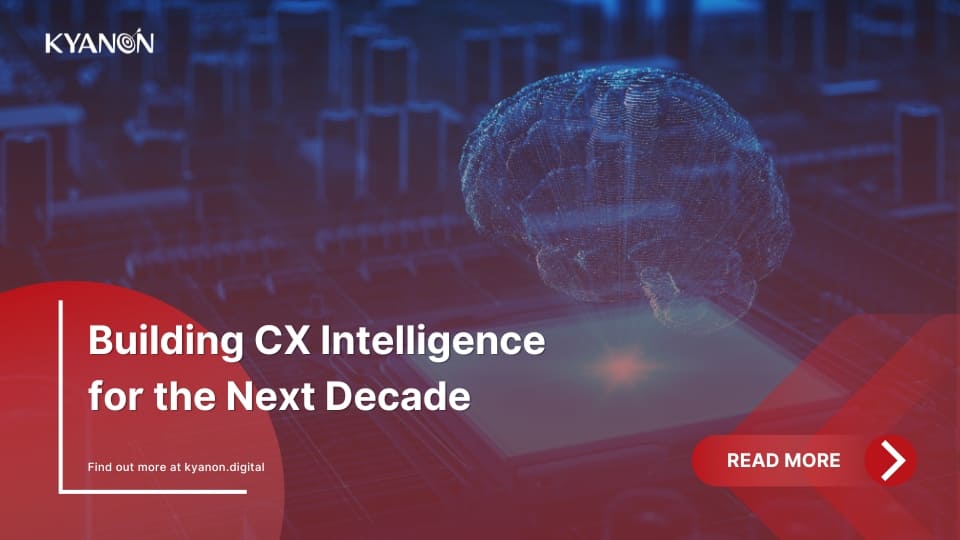In an era where artificial intelligence (AI) is central to digital transformation, training your own AI model is no longer a luxury reserved for tech giants. It has become a strategic lever for businesses seeking tailored, scalable, and future-ready solutions. This blog will unpack everything you need to know about building AI model training services, with practical insights on processes, costs, tools like Python, and the role of specialized engineers.
Further reading:
- How to choose the right AI consulting service partner for your business
- AI in Ecommerce and Retail: Trends, Use Cases, and Business Impact
- AI in Banking and Financial Services: Trends, Use Cases & Market Impact
Why Train Your Own AI Model?
The Limitations of Off-the-Shelf Models for Specialized Business Needs
Off-the-shelf AI models like GPT or BERT are designed for broad use, not your business’s unique problems. They often lack domain knowledge, can’t integrate easily with your systems, and may raise serious data privacy issues when hosted on third-party platforms. Worse yet, their performance plateaus when tasked with understanding nuanced workflows or specialized terminology, often requiring costly workarounds or manual review.
These limitations become especially problematic in high-impact use cases like medical diagnosis, fraud detection, or personalized recommendations-where even minor misjudgments carry real consequences. According to a 2023 Gartner report, over 50% of enterprises adopting off-the-shelf AI reported major limitations in domain accuracy and data governance. At scale, the gap between “generic” and “tailored” isn’t just a matter of quality-it’s a matter of competitiveness.
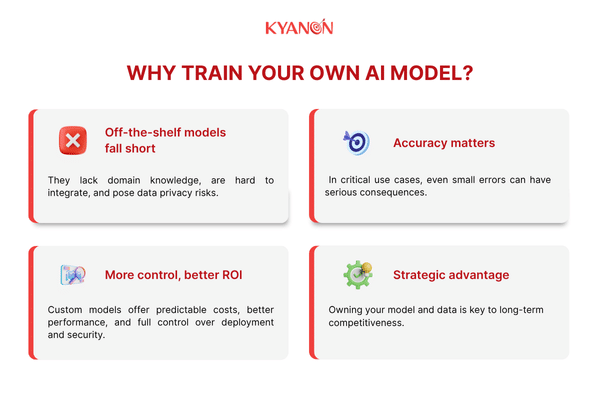
Key benefits of building your own AI Model: Faster, Cheaper, More Predictable, and Highly Customizable Results
Custom AI model training allows your business to take full ownership of performance and outcomes. Models trained on proprietary data understand your language, products, and KPIs-delivering better accuracy and fewer post-processing headaches.
Rather than paying ever-increasing API fees for limited functionality, custom models offer predictable investment and long-term ROI. You gain control over deployment, scalability, and data security-critical in regulated industries. According to McKinsey & Company, businesses deploying custom-trained AI see 20–30% improvements in operational efficiency.
With the right approach, it becomes faster to deploy AI that works exactly the way your business needs it to.
When to Consider Custom AI Model Training Over Generic LLMs
You should seriously consider training your own AI model when:
- Your business relies on proprietary or sensitive data.
- The task is too niche for general-purpose models (e.g., identifying rare diseases from scans).
- You need deep integration with existing platforms or infrastructure.
- High accuracy is essential and mistakes carry business risk.
- You want to internalize learning, not just fine-tune surface-level behavior.
Companies pursuing data-centric innovation are increasingly realizing that model ownership is not a luxury-it’s a strategic asset.
Andrew Ng – founder of Google Brain, co-founder of Coursera, and former Chief Scientist at Baidu – said, “Data quality, not model architecture, will determine AI success in the next decade.” This highlights the growing importance of focusing on data to drive AI advancements. (Forbes)
What Is AI Model Training?
Definition and Importance in the AI Lifecycle
AI model training is the process of teaching a machine learning model to make accurate predictions or classifications by feeding it structured data and letting it learn patterns. It’s one of the most critical phases in the AI lifecycle because the quality of training determines the model’s effectiveness, reliability, and business value.
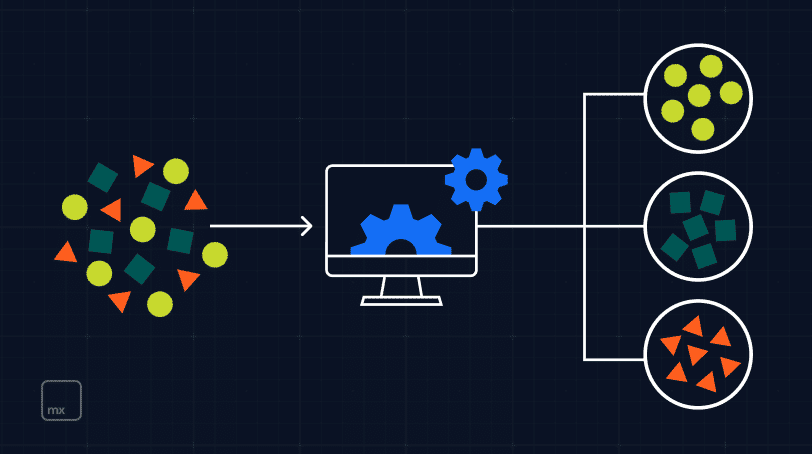
How Model Training Enables AI to Learn Patterns, Recognize Features, and Make Accurate Predictions
Through iterative learning, the AI model adjusts internal parameters based on feedback (error vs. actual outcome). Over time, it learns to generalize beyond the training data, recognizing patterns and making informed predictions on new, unseen inputs. This is what allows AI to deliver value in tasks ranging from customer segmentation to autonomous navigation.
Transform your ideas into reality with our services. Get started today!
Our team will contact you within 24 hours.
How to Train an AI Model in 7 Practical Steps
Training your own AI model may sound complex, but when broken down into seven clear steps, it becomes a manageable and rewarding process. Whether you’re building a fraud detection tool or a content generation engine, here’s how to get started:
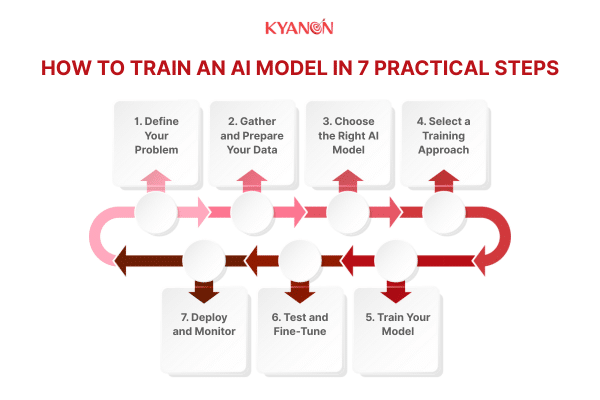
Step 1: Define Your Problem
Every successful AI project begins with clarity. Ask yourself: What problem are you trying to solve?
- Want to spot fraudulent activity faster? You’ll need data that includes examples of both normal and suspicious behavior.
- Looking to enhance customer experience? You should gather data on preferences, demographics, and past interactions.
- Need a tool to generate new content quickly? You can train a generative model using prompt engineering to get the results you want.
Understanding your end goal will help shape every other step, especially what data you’ll need and which model type to choose.
Step 2: Gather and Prepare Your Data
Think of training an AI model like preparing for an exam-studying the wrong material won’t get you the right results. In AI, quality matters more than quantity.
- Use real data (like user reviews, support tickets, or social media comments) to reflect real-world use cases.
- Or use synthetic data, which is especially useful in sensitive areas like healthcare, where privacy is a concern.
Types of training data:
- Text: documents, websites, chat logs
- Audio: voice commands, music, soundscapes
- Images: photos, scans, medical images
- Videos: surveillance footage, animations
- Sensor data: motion, temperature, biometrics
Once collected, data must be cleaned, labeled, and organized. This step often takes the most time-but it lays the foundation for everything else.
Step 3: Choose the Right AI Model
Now that you know the problem and have data in hand, it’s time to pick your model.
- Generative AI models (like GPT or image diffusion models) create new content such as text, images, and even music.
Example: Google Translate or ChatGPT. - Machine Learning models focus on identifying patterns to predict outcomes, detect anomalies, or make decisions.
Example: product recommendation systems or spam filters.
Your use case determines which is best.
Step 4: Select a Training Approach
There’s no one-size-fits-all method to train AI. Your approach depends on your data, goals, budget, and timeline.
For generative AI, common techniques include:
- Transformers: great for language translation and text generation
- GANs (Generative Adversarial Networks): ideal for creating realistic images or videos
- Diffusion models: generate detailed images by reversing noise into structure
For machine learning, you might use:
- Supervised learning: feed the model labeled data so it learns expected outcomes
e.g., labeling plant species in photos for classification. - Unsupervised learning: let the model detect patterns without guidance
e.g., grouping customers with similar purchasing behavior. - Semi-supervised learning: combine small labeled datasets with large unlabeled ones for efficient training
Choose the method that balances your available resources, computational needs, and project complexity.
Step 5: Train Your Model
This is where the real learning happens. Feed your prepared data into the model, and it will begin to understand patterns, relationships, and outputs.
During training:
- The model continuously improves by minimizing errors
- You may need to adjust its settings (called hyperparameters)
- Watch out for overfitting, where the model memorizes the training data but fails on new data
Think of it as teaching a student to solve math problems-not by memorizing answers, but by learning how to solve them.
Step 6: Test and Fine-Tune
After training, test your AI model with new data it hasn’t seen before. This helps you measure its performance in realistic scenarios.
Common evaluation metrics include:
- Accuracy – how often it gets things right
- Recall – how well it catches all relevant results
- F1-score – a balance between precision and recall
If results fall short, revisit your training data, tweak the model, or adjust the learning method. Then retrain and retest.
Step 7: Deploy and Monitor
Once your AI model performs well, it’s time to put it to work. You can deploy it:
- Through APIs
- In the cloud
- Embedded in apps or systems
But deployment doesn’t mean your work is done.
Ongoing maintenance is crucial. AI models can become outdated as data and trends evolve. Regular updates and retraining ensure continued relevance and accuracy.
4. Custom AI Model Training Services: What’s Included?
Opting for custom AI model training services offers a comprehensive suite of support designed to navigate the complexities of AI development. These end-to-end services significantly alleviate the technical burden on your organization, accelerating your time-to-value. A typical service package encompasses:
- Business Case Consultation: Aligning AI initiatives with your strategic objectives.
- Data Engineering: This critical phase involves meticulous data collection, rigorous cleaning, and precise labeling to ensure high-quality input for your model.
- Model Development & Architecture Design: Crafting the core structure and algorithms tailored to your specific needs.
- Training & Hyperparameter Tuning: Iteratively refining the model’s performance through data exposure and parameter adjustments.
- Model Optimization: Techniques like pruning and quantization are applied to enhance efficiency and reduce computational overhead.
- Deployment Pipeline Setup: Establishing robust systems for seamlessly integrating the model into your operational environment.
- MLOps Integration & Governance: Ensuring a streamlined, managed, and compliant AI lifecycle.
- Ongoing Support & Performance Monitoring: Continuous oversight to maintain optimal model performance and address any issues.
This holistic approach is not just about building a model; it’s about embedding AI effectively into your business processes, often leading to faster project delivery and tangible efficiency gains by leveraging specialized expertise and streamlined processes.
5. AI Model Training with Python: Tools and Example Workflows
Python stands as the undisputed champion in AI development, thanks to its rich and expansive ecosystem of libraries and frameworks. Its versatility makes it the preferred language for everything from data manipulation to deep learning. Key tools in the Python AI arsenal include:
- TensorFlow / Keras: Exceptional for developing and scaling deep learning models.
- PyTorch: Highly favored in AI research due to its flexibility and dynamic computational graph.
- Scikit-learn: A powerhouse for implementing classic machine learning models.
- Pandas & NumPy: Indispensable for efficient data manipulation and preprocessing.
- MLflow / DVC: Essential for experiment tracking and model versioning, ensuring reproducibility and accountability.
A typical AI model training workflow in Python often involves: ingesting raw data with Pandas, performing necessary preprocessing steps, training a model using powerful frameworks like TensorFlow or PyTorch, thoroughly evaluating its performance, and finally, deploying the model via frameworks such as Flask or FastAPI. Python’s dominance is further evidenced by the Stack Overflow Developer Survey 2024, which confirmed its widespread use and leading position among developers working in data science and machine learning.

6. Cost of Training an AI Model: Factors and Estimates
The cost associated with training an AI model can fluctuate significantly, primarily driven by its inherent complexity and specific requirements. While estimates vary, a general breakdown includes:
- Basic Models: Typically range from $10,000 to $30,000.
- Intermediate Models: Can cost between $50,000 and $200,000.
- Advanced Deep Learning or Large Language Models (LLMs): These projects often require substantial investment, ranging from $500,000 to over $5 million.
Several critical factors contribute to these costs, including:
- Data Quality and Volume: The cleanliness, quantity, and diversity of your data.
- Compute Resources: The need for powerful GPUs or TPUs for intensive training.
- Data Annotation: The labor-intensive process of labeling data. According to Labellerr.com (October 2024), which cites a 2024 Rand report, companies often allocate 25% to 50% of their total project budgets to labeling efforts.
- Cloud Usage: Expenses related to cloud computing infrastructure.
- Model Maintenance: Ongoing costs to keep the model relevant and effective.
Beyond the initial investment, hidden costs can arise from integration complexities, regulatory compliance requirements, hallucination filtering in generative AI, and the need to upskill your team to manage new AI capabilities.
If you’re planning to build your own AI training model, contact Kyanon Digital for a tailored consultation and an accurate cost estimate.
7. The Role of AI Model Training Engineers
AI Model Training Engineers are pivotal figures in the AI lifecycle, serving as the crucial link between theoretical data science and practical production deployment. These specialized professionals are responsible for transforming raw data and algorithms into robust, deployable AI solutions. Their core responsibilities typically include:
- Managing Complex Pipelines: Overseeing the entire data and model flow from ingestion to deployment.
- Training and Tuning Models: Systematically optimizing model performance for accuracy and efficiency.
- Integrating AI into Real-World Systems: Ensuring seamless deployment and interaction with existing IT infrastructure.
- Ensuring Scalability, Reproducibility, and Governance: Guaranteeing that AI solutions are capable of handling increasing demands, are consistently replicable, and adhere to organizational and regulatory standards.
The expertise of strong AI engineers is instrumental in fostering faster iteration cycles, achieving more reliable model performance, and ensuring a successful transition from the research and development phase to full-scale deployment.
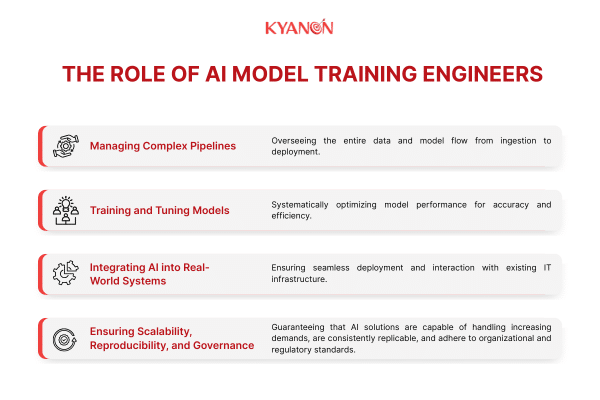
8. Why Choose Professional AI Model Training Services?
For most companies, building and maintaining an in-house team capable of managing end-to-end AI development is incredibly costly and inefficient. It often requires significant investment in specialized talent, infrastructure, and ongoing research. This is where partnering with a professional AI model training service provider becomes a strategic advantage.
These partners help your business:
- Reduce time-to-market: Accelerate the deployment of AI solutions, getting your products or services to customers faster.
- Avoid costly trial-and-error: Leverage expert knowledge and proven methodologies to minimize missteps and optimize development paths.
- Ensure compliance and scalability: Benefit from solutions designed with regulatory standards in mind and built to scale with your growing needs.
- Focus on core business: Delegate the complexities of AI development, allowing your internal teams to concentrate on their primary objectives and innovation.
- Access cutting-edge tools and talent without overhead: Gain immediate access to advanced AI technologies and highly skilled professionals without the burden of recruitment, training, or infrastructure costs.
Working with specialized AI outsourcing partners can significantly reduce development costs. For instance, CSV Now (2025) indicates that companies can reduce costs by 40-60% while gaining access to top talent and accelerating implementation timelines.
Ultimately, outsourcing AI model training isn’t about giving up control; it’s about accelerating results and achieving superior outcomes by collaborating with a trusted, specialized partner.
9. Kyanon Digital: Your Trusted AI Model Training Partner

As a trusted leader in AI development company, Kyanon Digital delivers tailor-made AI solutions ranging from intelligent chatbots and data extraction tools to advanced business automation systems. Our expertise extends to AI model selection, development, training, and ongoing optimization, ensuring seamless performance and long-term value.
What makes Kyanon Digital different?
- Human-Centric Design: We design solutions that are intuitive, impactful, and crafted to solve real-world challenges while enhancing user experiences.
- Engineering Excellence: With our Center of Excellence (CoE) driving innovation, we deliver scalable, reliable, and future-ready digital solutions.
- High-performance Agile Teams: Our expert teams seamlessly integrate with yours, combining technical expertise, agile mastery, and transparent collaboration to deliver adaptable, high-impact results.
Case study: Building an AI-powered Legaltech Platform with Kyanon Digital
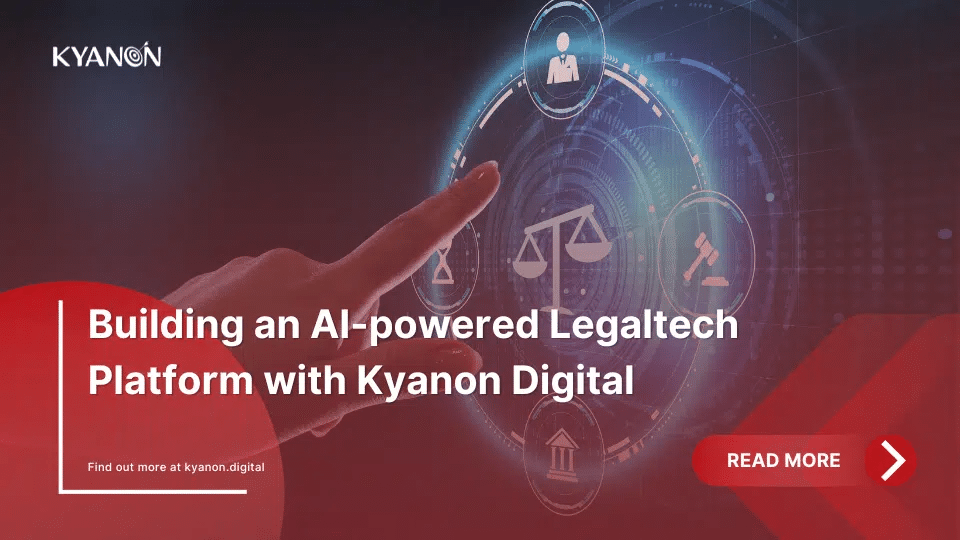
Kyanon Digital transformed a Legaltech startup’s challenge into an AI solution, showcasing expertise in building your own AI model training services.
A specialized AI model was trained on EU law, utilizing Retrieval-Augmented Generation (RAG) for accurate, personalized legal advice. This included data preparation, architecture design, and continuous training.
With human-centric design, Kyanon Digital created an intuitive chatbot. Engineering excellence enabled multi-model compatibility and automated complex legal workflows. 24/7 system stability was ensured via continuous monitoring.
The result: streamlined legal workflows, reduced manual load, and a scalable AI architecture. This project solidifies Kyanon Digital’s role in delivering tailored AI solutions with clear business value.
Find out more: Building an AI-powered Legaltech Platform with Kyanon Digital
Conclusion
Building your own AI model training services offers a powerful competitive edge. While off-the-shelf models are a start, training your own AI model on proprietary data delivers unmatched accuracy and customization. This complex process, from problem definition to deployment, benefits from tools like Python and insights into AI model training costs.
For many, partnering with a professional custom AI model training service is the most strategic move. This approach drastically cuts time-to-market and project risks, freeing your team to focus on core business.
Choosing the right AI consulting service partner is crucial. They should offer strategic alignment and industry insight alongside technical expertise. Kyanon Digital specializes in guiding companies through their AI journeys, blending technical excellence with deep industry knowledge to deliver secure, future-ready solutions tailored to your goals.
Ready to accelerate your AI initiatives? Contact Kyanon Digital today to explore how our tailored AI consulting services can drive measurable business value for you.
References
- 3 Bold and Actionable Predictions for the Future of GenAI, Gartner
- Superagency in the workplace: Empowering people to unlock AI’s full potential, McKinsey & Company
- AI Model Training: What it is and How it Works, Mendix
- The 2023 Developer Survey, Stack Overflow
- Andrew Ng Launches A Campaign For Data-Centric AI, Forbes



